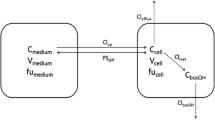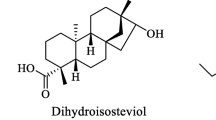Abstract
Due to the cyclical natural of the vitamin K-vitamin K epoxide system, a two-compartment reversible metabolism model was used to describe this interconversion. In attempting to apply this model to the vitamin K-vitamin K epoxide cycle using literature data from dogs, interconversion and elimination clearances were obtained which are not physiologic. Consequently, the assumptions of the model were reexamined with respect to their validity. One critical assumption of the twocompartment model for interconversion is that it can only be applied in the absence of flow limitations. To determine what effect flow limitations may exert on the vitamin K and vitamin K epoxide apparent blood clearances, a model separating the liver from the blood compartment was proposed assuming the interconversion and metabolism of vitamin K and its epoxide occurred only within the liver. Simulated data suggested that if the reversible metabolic clearance values exceeded the distributional clearance terms, all the apparent clearances calculated using blood concentration-time data were in error. It is suggested that a two-compartment interconversion model might be too simplistic for the vitamin K-vitamin K epoxide cycle where the reversible metabolism is efficient and the distributional clearance may be rate limiting.
Similar content being viewed by others
Abbreviations
- Dose E :
-
Dose of vitamin K epoxide
- Dose K :
-
Dose of vitamin K
- AUC EE :
-
Area under curve for vitamin K epoxide after epoxide dose
- AUC KE :
-
Area under curve for vitamin K after epoxide dose
- AUC KK :
-
Area under curve for vitamin K after vitamin K dose
- AUC KE :
-
Area under curve for vitamin K epoxide after vitamin K dose
- AUC EL,E :
-
Area under curve for vitamin K epoxide after epoxide dose
- AUC EL,K :
-
Area under curve for vitamin K after epoxide dose
- AUC KL,K :
-
Area under curve for vitamin K after vitamin K dose
- AUC KL,E :
-
Area under curve for vitamin K epoxide after vitamin K dose
- Cl BE :
-
Elimination clearance of vitamin K epoxide
- Cl BK :
-
Elimination clearance of vitamin K
- Cl BE→K :
-
Conversion clearance from vitamin K epoxide to vitamin K
- Cl BK→E :
-
Conversion clearance from vitamin K to vitamin K epoxide
- Cl LE :
-
Elimination clearance of vitamin K epoxide
- Cl LK :
-
Elimination clearance of vitamin K
- Cl LE→K :
-
Conversion clearance from vitamin K epoxide to vitamin K
- Cl LK→E :
-
Conversion clearance from vitamin K to vitamin K epoxide
- Cl B→LK :
-
Clearance of vitamin K from the blood to the liver
- Cl L→BK :
-
Clearance of vitamin K from the liver to the blood
- Cl B→LE :
-
Clearance of vitamin K epoxide from the blood to the liver
- Cl L→BE :
-
Clearance of vitamin K epoxide from the liver to the blood
References
J. W. Suttie. Recent advances in hepatic vitamin K metabolism and function.Hepatology 7:367–376 (1987).
W. F. Ebling and W. J. Jusko. The determination of essential clearance, volume and residence time parameters of recirculating metabolic system: The reversible metabolism of methylprednisolone and methylprednisone in rabbits.J. Pharmacokin. Biopharm. 14:557–599 (1986).
H. Bechtold, D. Trenk, T. Meinertz, M. Rowland, and E. Jahnchen. Cyclic interconversion of vitamin K and vitamin K 2,3 epoxide in man.Br. J. Clin. Pharmacol. 16:683–689 (1983).
D. M. Carlisle and T. F. Blaschke. Vitamin K1, vitamin K1 epoxide and warfarin interrelationship in the dog.Biochem. Pharmacol. 30:2931–2936 (1981).
C. Vermeer.γ-Carboxyglutamate containing proteins and the vitamin K dependent carboxylation.Biochemistry 266:625–636 (1990).
B. Furie and B. C. Furie. Molecular basis of vitamin K dependentγ-carboxylation.Blood 75:1753–1762 (1990).
J. Doyle. Stella® High Performance Systems, Inc., 45 Lyme Road, Hanover, NH 03755 (1988).
Y. Yamanaka, M. Yamano, K. Yasunaga, T. Shike, and Y. Uchida. Effect of warfarin on plasma and liver vitamin K dependent levels and vitamin K epoxide reductase activity in relation to plasma clotting factors levels in rats.Thrombosis Res. 57:205–214 (1990).
Author information
Authors and Affiliations
Additional information
Supported by a grant from The American Heart Association, Kentucky Affiliate.
Rights and permissions
About this article
Cite this article
Hallak, H.O., Wedlund, P.J. Reversible metabolism of vitamin K-vitamin K epoxide: Modeling considerations and limitations. Journal of Pharmacokinetics and Biopharmaceutics 20, 1–18 (1992). https://doi.org/10.1007/BF01143184
Received:
Revised:
Published:
Issue Date:
DOI: https://doi.org/10.1007/BF01143184




